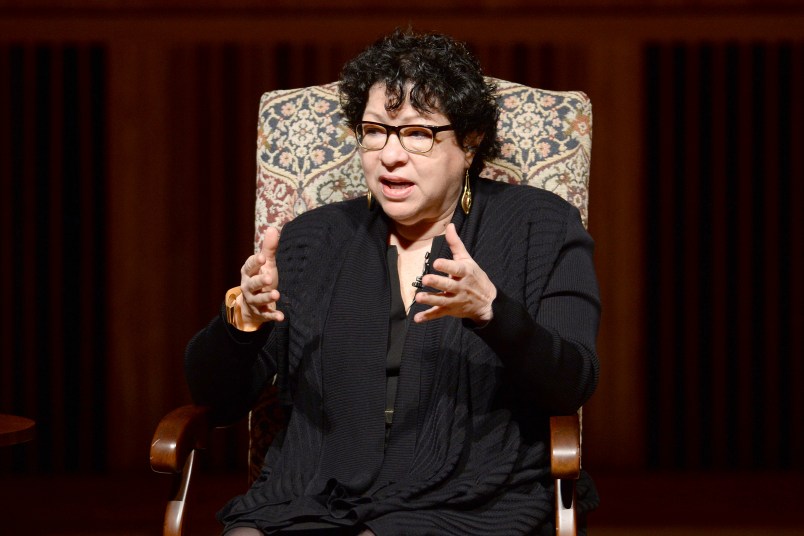Ahead of Wednesday oral arguments for a Supreme Court case that could boost efforts to aggressively purge voter rolls, voting rights advocates weren’t optimistic that they’d get a sweeping ruling in their favor, given the court’s conservative make-up. Rather, some hoped merely that the court might rule narrowly against Ohio’s system for removing voters, which they see as the most restrictive in the nation.
Wednesday’s hearing suggested even more strongly that that’s the best voting rights advocates can hope for. Some of the liberal justices seemed eager to limit the case to the issue of Ohio’s specific system. But there were signs that the court could be poised to issue a broader ruling that gives other states permission to aggressively purge their rolls, potentially disenfranchising large numbers of legitimate voters.
The case, Husted v. A Philip Randolph Institute, is a challenge to a method Ohio uses to purge its voter rolls. The plaintiffs, a coalition of local civil rights organizations, allege that it violates the National Voter Registration Act (NVRA).
Under Ohio’s “Supplemental Procedure,” a voter who does not vote within a two-year period is sent a mailer asking her to confirm or amend her address. If the voter does not respond to the mailer, and does not vote within the next four years of elections, she is removed from the rolls.
In oral arguments, the tension between the practical effect of how Ohio purges its rolls and the more abstract statutory questions at play was on display.
Paul Smith, the lawyer for the plaintiffs, argued that any use of non-voting to begin the removal process was illegal. Smith pointed to the NVRA provision that says a state’s purge process “shall not result in the removal of the name of any person ….by reason of the person’s failure to vote.”
“Suppose the state statute said that if you have not voted for 20 years then we’re going to send out the notice. Would you say that that violates this Act?” asked Justice Sam Alito, who was Ohio’s biggest booster during questioning.
Smith said yes, “because the Act says you can’t use failure to vote as the reason for purging somebody from the roll.”
But Smith also stressed that Ohio’s specific regimen is flawed. He noted that 70 percent of the 1.5 million confirmation notices that state sent in 2011 were not returned. He called the process “vastly over broad” and rife with “a lot of false positives.”
Sotomayor, too, turned the discussion to Ohio’s system specifically. She noted that voters who did not return the mailers were immediately put on the inactive list, meaning they would not receive the notices active voters received about their polling places and upcoming elections. She brought that issue up again when Smith had his turn for rebuttal.
Those comments from Sotomayor seemed to suggest that she thought that a narrow ruling, that opposed Ohio’s process on the grounds that it’s particularly strict, was their best chance at convincing the other justices to vote against it, regardless of whether the NVRA lets states use nonvoting in their purge protocols. It’s not clear what justice from the conservative bloc would swing to her side.
Alito said the key question was simply how to interpret the NVRA, and suggested he interpreted it differently from Smith.
“Not a question of what we think would be the ideal system for achieving the result of removing people who have moved from the voter lists,” Alito said.
Nonetheless, Justice Ruth Bader Ginsburg brought up that Ohio used a person’s failure to vote in one federal election cycle to start the process, and asked Ohio Solicitor General Eric Murphy how other states’ used non-voting under their regimens.
He noted that many states used nonvoting in two, three, or four-year periods as part of their purge process. He said if Smith’s interpretation of the NVRA was correct, it would outlaw any state that used a nonvoting as a factor for purging.
When Sotomayor asked Murphy for statistical evidence to back up Ohio’s belief that nonvoting is reliable way to infer that someone has moved, he shot back that no statistical evidence is necessary under the NVRA.
Chief Justice John Roberts challenged the idea that nonvoting was the only factor Ohio was using, since the state also sent out the confirmation mailers. And he even questioned whether a person has the constitutional right not to vote, as Smith had suggested.
The court’s two most conservative justice, Justices Clarence Thomas and Neil Gorsuch did not speak during the oral argument, while Justice Anthony Kennedy’s questions didn’t reveal much about his thinking.
Even left-leaning Justice Stephen Breyer appeared sympathetic to the challenges states face in keeping their voter rolls up to date.
If Ohio’s system gets an explicit green light from the Supreme Court, voting advocates fear that other states will follow its model. Voter fraud alarmists could even use such a ruling as a cudgel to pressure election officials to more aggressively purge their rolls.
Encouraging states to conduct purges would dovetail with an administration priority. It appeared to be a major goal of the White House commission on voter fraud, which was disbanded last week.
By contrast, even a narrow ruling against Ohio could ward off other states from implementing such extreme systems. But getting five votes for that may even be a reach, despite Sotomayor’s best efforts.
Correction: This story mischaracterized a question from Chief Justice John Roberts. He asked about the constitutional right not to vote, rather than the constitutional right to vote.
Read the latest editor’s brief (Prime access) on this story »










